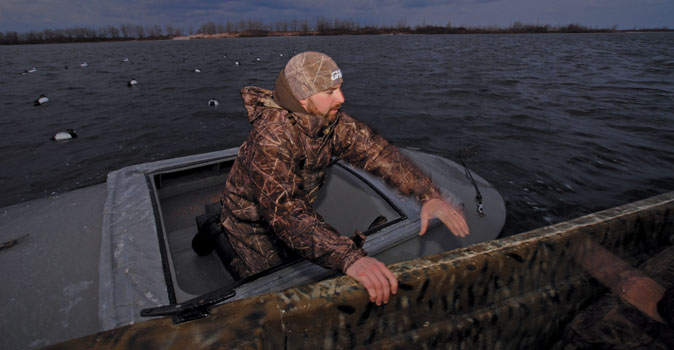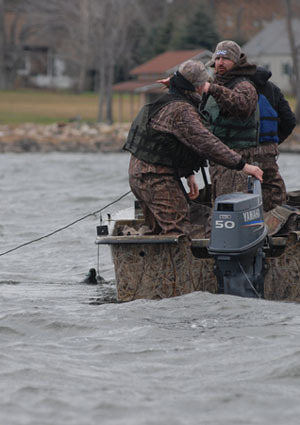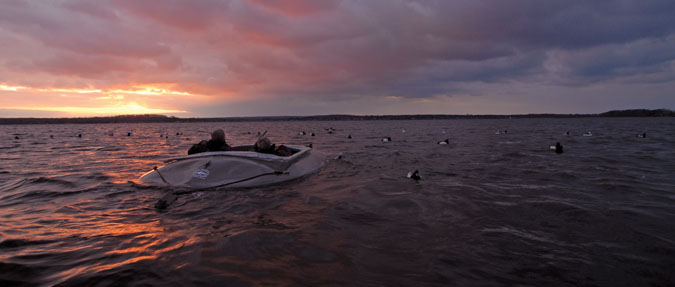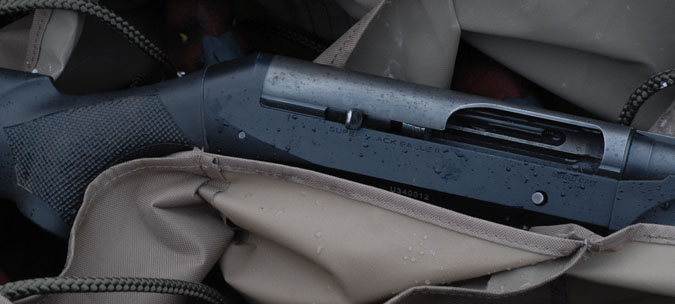
"Watch out for the spray, and you’ll really need to get your legs completely down. I know — it's a weird feeling, but you'll get used it," said Ron Zaga, USDA Wildlife Biologist and Avery Prostaffer.
With the wind picking up and water spraying over my neck, the dawn peeked red through the cloudy sky with the temperature holding at 30 degrees. It’s no wonder I shot a boat length behind the first group of barnstorming buffleheads when they screamed over the dekes. It was so awkward I was just happy to get two shots off. With the last bufflehead on the edge of “out-of-range," Ron dumped the bird with one shot. "I wanted you to get the first duck, but this laying on your back and shooting stuff can take some getting used to. Besides, I waited 'til after you shot," he exclaimed. Getting a clean kill at a 45-yard diver flying at 50 miles an hour, Ron had nothing to be ashamed of.
Getting comfortable in a layout boat is a truly a skill. However, once you adapt to the right position, pull the hood on your jacket up high, and find your swing, there’s nothing like it in the world of waterfowling.
The next batch of birds turned to the west and graciously gave me a close right-to-left swing. In turn, two goldeneyes splashed into the chilly waters of northern New York’s Lake Oneida. "See, I told you that you’d find your swing. Wait until two or three bunches work us at the same time, it’s a riot," said Zega.
The morning passed by quickly with a mix of birds that included a single bluebill, several goldeneyes and a bufflehead. They came feather-fast to my Super Black Eagle. As limits filled, Ron and I traded out with the tender boat crew, taking our place chasing down cripples and picking up shot birds with a 6-foot-long steelhead net.
Laying Down On The Job
 When asked why someone would lay flat on the water under some of the most precarious circumstances in waterfowling, my host Mike Bard said, "Because it works. Hunt out of a traditional boat and you’ll kill some divers. When it’s right, you’ll do well, although it may take you all morning and part of the afternoon. But if you’re smart about your decoy rig and willing to lay down flat in a boat…you’re often done in an hour," he said.
When asked why someone would lay flat on the water under some of the most precarious circumstances in waterfowling, my host Mike Bard said, "Because it works. Hunt out of a traditional boat and you’ll kill some divers. When it’s right, you’ll do well, although it may take you all morning and part of the afternoon. But if you’re smart about your decoy rig and willing to lay down flat in a boat…you’re often done in an hour," he said.
The other attraction to lying down is how close the birds fly over you. Hearing a diver within 12 feet whistling by low and fast creates memories of sights and sounds that are remarkably different than most days in the sloughs of the Midwest. Although hunting the marsh is an experience I’ll never give up, laying down for divers is truly different.
In northern New York State, Bard says that he has seen a handful of layout boats. "Ducks are just not used to being pressured in open water from an ultra-low platform they can’t figure out. We have most of our favorite open-water haunts to ourselves," he said.
It Takes A Village
As Bard put it, "You have to have help or it’s just plain dangerous." Mike and his crew, "The Game-Hog Hunt Club," use a two-man layout boat made of Kevlar that weighs an easy 160 pounds. "It takes a minimum of four guys to hunt in the layout boat, while the other two run the tender boat to service the needs of the layout hunters," said Bard.
In calm water or at a short distance from shore, the layout boat can be towed. But in most cases, the oval boat is set on top of the tender boat and piggybacked to the spot.
Other tricky transfers include getting the hunters into the layout boat. With the wind up only a few knots, the game changes. "All it takes is a breeze much over 15 miles an hour and ice, then getting in or out of the layout boat can be really hairy. The two guys in the tender boat hold on while the hunter almost rolls onto the floor of the layout craft. The idea is to distribute as much weight to the floor as quickly as possible," said Bard. He also mentioned that everyone wears a life vest at all times.
Rest Or Feed
When chasing divers, scouting plays a critical role. This crew looks for divers feeding. "If we locate feeding ducks in the water, they will be in less than 25 feet and usually closer to shore," said Rick Murphy, Wildlife Biologist for the USDA.
The crew finds that feeding birds present less pressured morning hunts that don’t require setting up rigs in the darkness. As a bonus, they can provide limits very quickly. Although many hunters will go after loafing birds later in the day, Murphy says that divers will loaf anywhere they feel safe, and that’s often way off shore in difficult-to-rig deep water.
In northern New York, most feeding birds are in a manageable 20 feet of water or even less, making it easier to predict where the divers will appear.
Big Wind And Bad Weather

After my first successful day, the crew planned to go to one of the many bays on Lake Ontario for our second outing. The temperature hovered around 28 degrees and the wind was predicted to hold to about 10 miles an hour.
As best laid plans go, this one was looking pretty good. In addition to Ron, Mike and Rick from the day before, we added another diver hand, Frank Clifton. It was Frank who said, "You can’t depend on the weather around Ontario; we’ll be lucky to hunt for two hours."
As we set the layout boat in 15 feet of water, the sun cracked through the partly cloudy sky just in time to give us a glimpse of divers skating by. Today it was Mike’s and Frank’s turn to start the hunt. The rest of us tended to their needs in addition to watching the weather rapidly deteriorate, just as Frank had predicted.
In just an hour, the bay’s flat picturesque water started to swell and the wind really began to howl. It wasn’t long before the gusts kicked up from 25 to 35 mph — and what was a hopeful morning became so dangerous that we had to abandon the layout boat.
The goal was to pick everything up, head into a cove and grab a bite via the Coleman stove stashed in Mike’s boat. If the wind died down, we would try again later.
It’s All About The Food
With the tender boat tucked in against a bank of trees as a windbreak, we inhaled massive quantities of eggs and sausage rolled in burritos for sustenance to stand up against the howling wind.
As if the gale winds and cold weren’t enough, heavy amounts of lake-effect snow that felt like large sleet began to fall. The crew threw down hot coffee and caloried up with the realization that as soon as our meal was finished, so were we.
"When water goes from spray to waves, you have to call it a day. When a big wave soaks you from behind, no matter how many birds are still flying, you just need to pick your gear up and head home. I’m sorry we didn’t get to hunt with you today, but I have no interest in fishing a body out of the bay," said Bard.
Gear Demands

If waterfowling is for true gear geeks, layout boat diver hunters just might be the kings of the pond.
Every piece of gear is carefully chosen down to the slotted Avery bags that keep the diver decoys clean, untangled and easy to set out. Other necessities include neoprene gloves and 3-pound custom grapple anchor weights. To keep the layout boat relatively dry, this crew chose the mighty ShamWow towels.
You’ll need to commit to a single or two-man layout boat. Bard recommends buying one from a reputable company that meets all Coast Guard regulations for flotation.
He added that learning layout ways should be done before the season is cold and windy. Training for a few days in warm weather over calm water that you can stand up in will serve you well in preparation for the ice and darkness. Practicing getting in and out of the boat and determining how fast or slow you have to run when towing is all part of being ready for that first cold day when bluebill, bufflehead, goldeneyes and redheads crash dive your decoys with reckless abandon.
The Author’s Shopping List For Divers
Layout boats that are stable and safe:
For diver decoys, bags and rigging:
Breathable waders and all things ducky:
The Game Hogg Crew tips, DVDs and waterfowl Hoggology:
Don’t forget the ShamWow:






